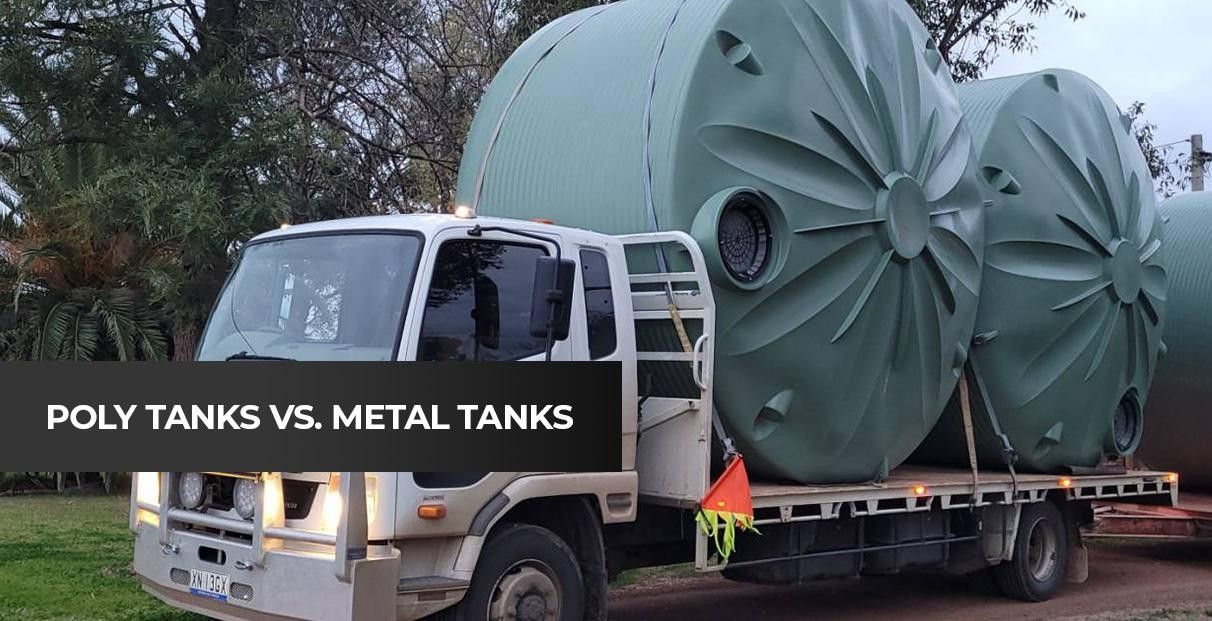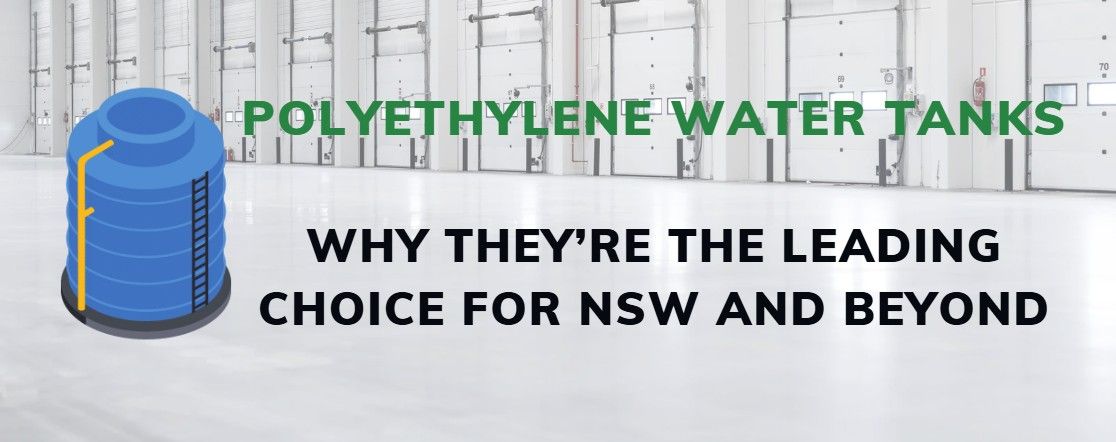
Poly Tanks vs. Metal Tanks | Which Is Best for Your Water Storage Needs?
Fetching water from the tank for household needs is probably the first task of many, every morning. However, how many really bother to check the condition of the tank? Water tanks are often, when subject to random checks, found getting damaged by rust, cracks, and corrosion. Repair of such damage is not only expensive but also frustrating. On the contrary, wouldn’t it be great to have a quality tank that’s made to withstand the harshest weather conditions and survive the toughest of physical challenges? If you consider investing in such a high-quality tank that works best even in extreme seasonal conditions, there’s no reason to be concerned about corrosion, rust, cracks, or leaks for years to come.
Another dilemma people in Australia typically face is the choice between poly and metal water tanks. Our experts believe that in a country like Australia that faces distinct and unpredictable weather conditions every day, choosing the right water tank cannot be just about storage. It’s rather about dependability and peace of mind in the long run. If you’re also one of those stuck between poly tank or metal tank trouble, it’s necessary that you first check the suitability of both for your location, needs, and budget.
As an established Poly Water Tank Manufacturer over the years, we understand your position because making the right choice isn’t always a simple job. Enviroform offers expert recommendations on the best suitable quality tanks for your water storage needs.
Want to avoid the hassle of costly repairs or replacements?
Explore our poly water tanks selection today!

What Are the Key Differences Between Poly and Metal Water Tanks?
Material plays a crucial role when it comes to choosing a water tank. The material used for tank determines its lifespan, performance, and maintenance requirements. When the discussion is about poly and metal tanks, each type has its peculiarities. The best you can do is to make your choice entirely based on your usage and needs.
Manufactured from high-density polyethylene (HDPE), poly tanks Australia are best known for their excellent corrosion resistance, and incredible flexibility. The strength of plastic material also renders these tanks the much -needed durability. These polyethylene water tanks are available in a variety of sizes and shapes, reflecting a versatile range of application possibilities. Whether you’re looking for a tank for your home, business, or farm. One of the biggest benefits of poly tanks is their corrosion and rust resistance.
On the contrary, metal tanks have to deal with rust and corrosion more often and thus are seen to be more susceptible to wear and tear. Poly tanks prove to be the best option for those residing in coastal regions with high humidity and salty air. As these tanks are made from galvanised steel, they demonstrate excellent strength and durability. Lasting longer, metal tanks need proper regular maintenance, especially in those areas with salty environments, or heavy rainfall.
What Are the Pros and Cons of Poly vs. Metal Tanks?
Extreme and unpredictable weather conditions are routinely in Australia. It thus makes it necessary to select the right water tank material for your needs. Now that the basic differences are clear enough, let’s discuss both the advantages and disadvantages of poly and metal tanks for water storage in Australia.
Poly Tanks:

Advantages:
1. Corrosion Resistance
As poly tanks display excellent resistance to corrosion and rust, they are often perceived as an ideal option for those in coastal areas where metal tanks often fail to combat saltwater exposure.
2. Durability Under Impact
The flexibility of poly tanks works best when it comes to impacts. Whether it’s a rock, a stray branch, or other external forces, it’s less likely that a poly tank will puncture or crack, unlike its metal counterpart.
3. UV Resistance
UV-stabilised poly tanks specifically designed to withstand the harsh Australian sun perform best without showing brittleness or degradation over time. This makes them an ideal option for areas constantly exposed to sunlight.
4. Easy Installation and Low Maintenance
Light weight of polyethylene water tanks facilitates their installation and transport. When compared to their metal counterpart, these tanks are low maintenance.
5. Cost Efficiency
When it comes to calculating the initial costs and maintenance expenses that follow, poly tanks are more affordable than metal tanks. It makes a big difference for Melbourne homeowners and farmers who are on long-term budgeting.
Disadvantages:
1. Extreme Heat Vulnerability
Although poly tanks are UV-resistant, regular exposure to intense sunlight or extreme heat often leads to softness or warps, ultimately affecting their structural integrity.
2. Reduced Lifespan Under Extreme Conditions
While poly tanks are best known for their endurance, their durability may be tested in areas with extreme temperature fluctuations. Repetitive heat and cold fluctuations leading to constant expansion and contraction of the plastic material. This may cause degradation over time.
Metal Tanks:

Advantages:
1. Long-Term Durability
Metal tanks are meant to last for years, even decades, if subject to careful maintenance. Corrosion- and rust-free areas are the ideal locations for metal tank installation. Moreover, if a tank that can withstand heavy pressure is required, a metal tank certainly is a strong contender.
2. Strength and Capacity
When we discuss strength, metal tanks are often stronger than their poly counterpart. Their capacity to hold more water without the risk of bursting proves to be an excellent attribute for those who need a storage solution for larger volumes of water.
3. Sleek Appearance
The traditional look of metal tanks is best suitable for vintage property types or industrial settings.
Disadvantages:
1. Susceptibility to Rust
High vulnerability to corrosion and rust is the biggest drawback of metal tanks. This is a more commonly observed scenario in coastal areas with humid climate and salty air. The integrity of the tank is thus compromised over time.
2. Heavier and More Expensive
Metal tanks are heavier in weight when compared with their poly counterpart. They are more expensive as well. Along with difficulty in their transport and installation, higher costs of these tanks make their initial investment and long-term maintenance costlier.
3. Higher Maintenance Needs
Regular maintenance is a must when it’s a metal tank because rust or corrosion has be checked more often. The overall costs are thus higher.
Have questions about choosing the right water tank? Contact our experts for guidance on selecting the ideal solution for your property.

Why Are Poly Tanks Often Preferred for Residential and Agricultural Use?
Poly tanks have become the go-to choice for both residential and agricultural water storage needs in Australia. The flexible design and lighter weight of poly tanks position them as an ideal choice in rural or remote areas. Farmers all over Australia have been appreciating the benefits of poly tanks in terms of costs, durability, and ability to withstand environmental adversities. On the other hand, homeowners have been readily investing in quality poly tanks for the convenience that they offer, dependability, and low maintenance. To ensure safe and sufficient water supply throughout the year, we recommend both household and agricultural users to choose from a variety of sizes and configurations of poly tanks.
Concluding Thought
Now that you understand the key differences, pros, and cons of poly and metal tanks, it’ll be easier for you to make an informed decision about your water storage solution. If you’re looking forward to a highly durable, best-quality, poly water tank made to stand the test of time and ready to pay a premium for it, Enviroform Australia provides a host of options in poly tanks.
Poly tanks are a more reliable option when it comes to handling extreme Australian weather, providing you with peace of mind that your water supply will remain safe and intact, no matter what the weather throws at you. Our tanks withstand the harsh Australian climate and are thus reliable for every water storage need. Don’t wait until it’s too late to make the right choice for your water storage. We believe you deserve a long-lasting solution to your water storage needs and the peace of mind.
Ready to secure your water supply with a durable poly tank?
Browse our range of high-quality poly water tanks and make your purchase today!
Contact Us
Copyright 2021-2025 © Enviroform. All rights reserved.
By Webplanners


